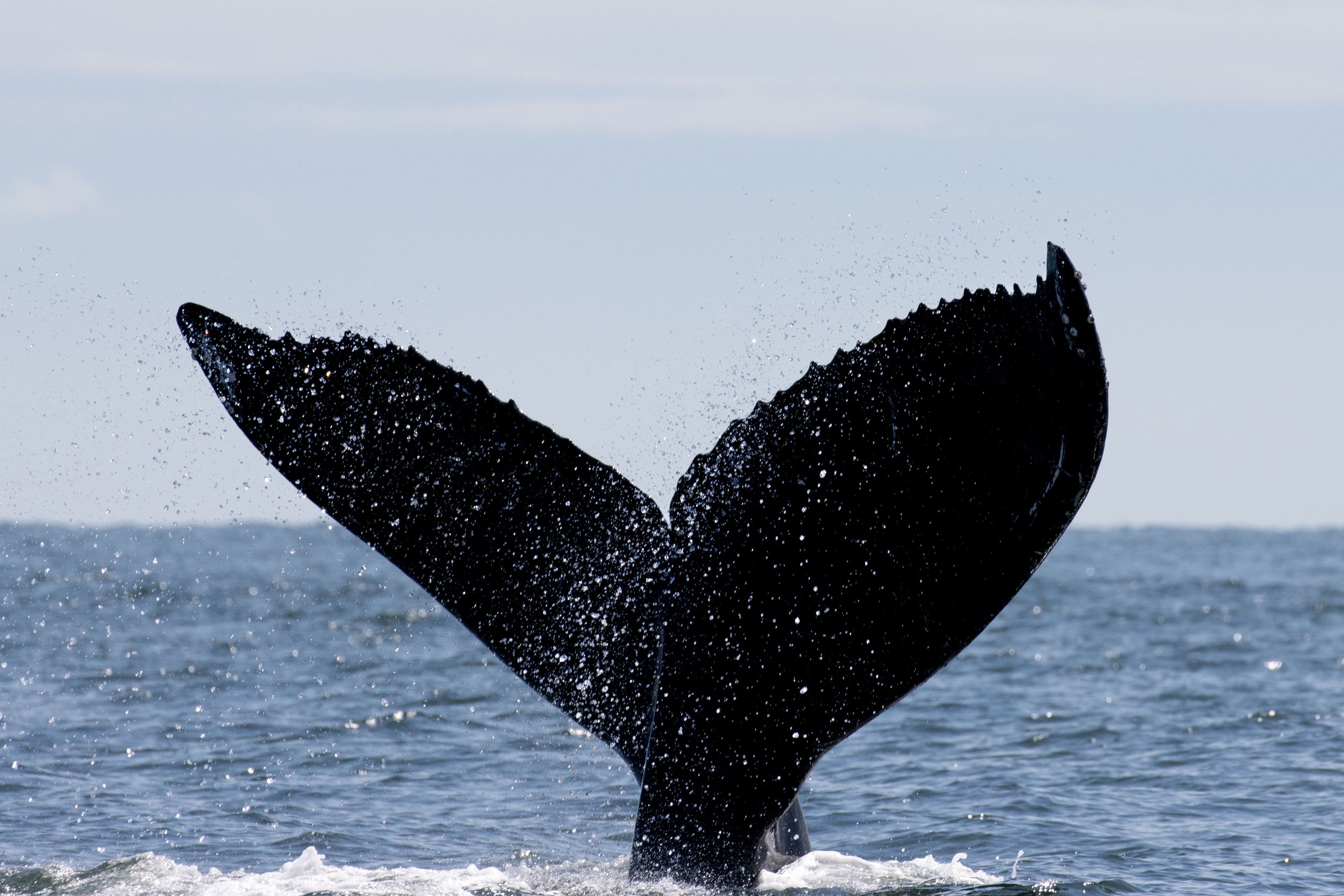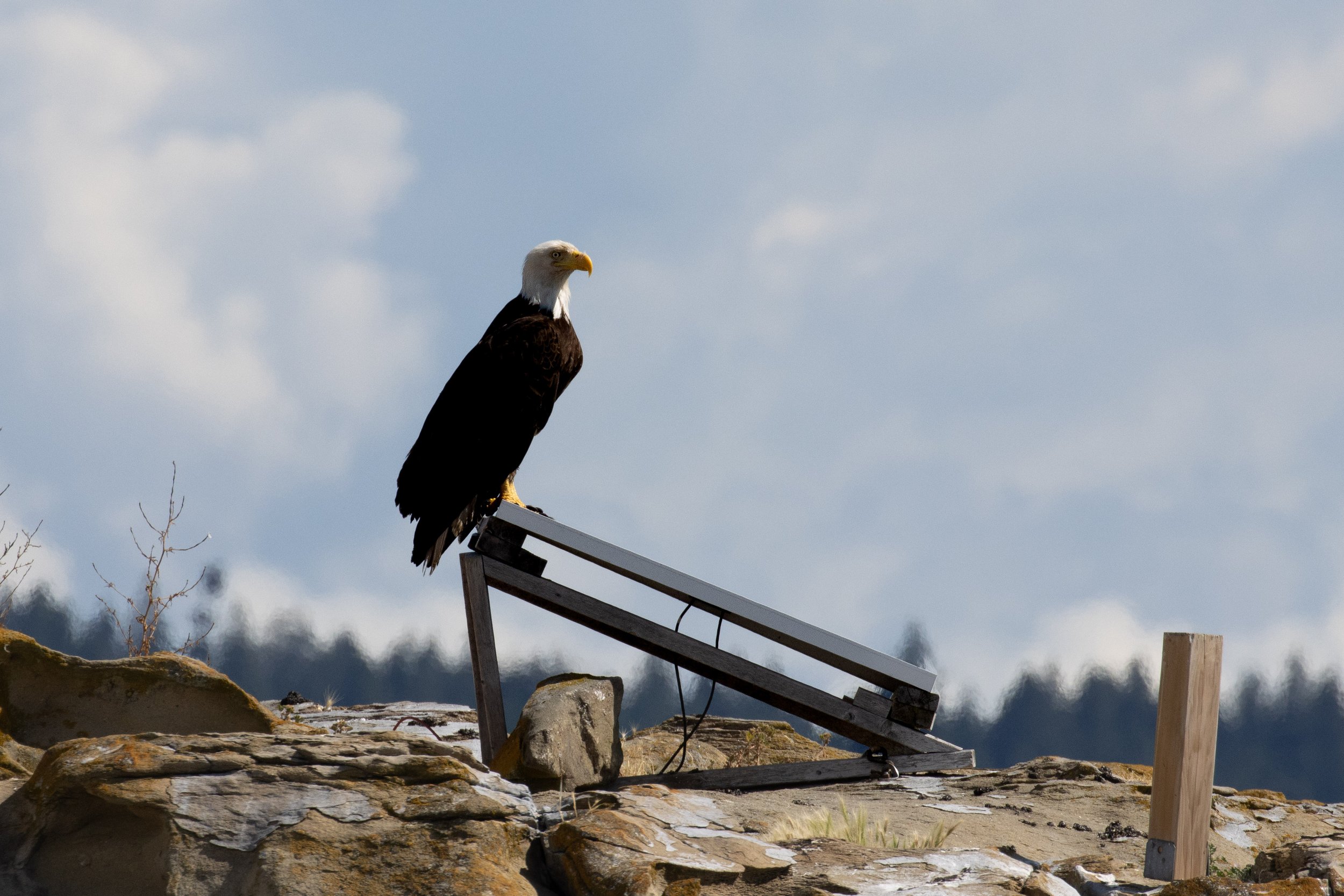July 25, 2024, 10:30 am - Lots of Humpbacks in the Strait of Georgia
It was a beautiful, sunny day when we had three of our boats leaving the Nanaimo Harbour to start searching the Salish Sea for today’s whales. Given that there are no trackers or tags on the whales, each day is a fresh start, and we head out not knowing where we might spot the whales! We aren’t searching alone either, not just boats within the same company will share sightings, but across companies will share sightings as well. It’s a big ocean to search all on your own! Today it was one of these shared sightings that we got word of during our search, so we headed towards Porlier Pass where there was a humpback whale!
Thanks to a high fluke and a relatively distinct dorsal fin, we quickly figured out that this whale was Olympus (BCX2075)! Olympus seemed to be feeding in the area, following the underwater formations off the East side of Galiano Island. Here there is a shelf that drops from the much more shallow water close to the island to the very deep water in the middle of the Strait of Georgia. Areas like this are quite popular feeding areas for animals. The abrupt change in depth leads to changes in current and mixes the water column more. This brings the cooler water to the surface where more oxygen can be dissolved, and it can be used by the primary producers to grow and reproduce. The primary producers that I’m talking about are called Phytoplankton, which are microscopic free-floating organisms that use the sun as their main source of energy. These organisms are then eaten by the “animal-like” plankton, or zooplankton, which are usually the larval stages of many sea critters that we know and love like crabs, clams, barnacles, and more! These small plankton would eat the phytoplankton and, in turn, be eaten by larger plankton like Krill! The humpbacks in our area are sometimes after these clouds of krill that are rich in our waters, but also the groups of small schooling fish that might be feeding on the same plankton.
While we don’t know which of the animals Olympus might have been after under the water today, we enjoyed spending our time with her as she fed. Soon though, our time with Olympus came to an end, and we started to leave. While we were making our way away from her, another whale suddenly surfaced! This whale wasn’t as cooperative with their tail, but thanks to some pigmentation on their dorsal fin and a scar from satellite tagging in the past, we identified this whale as Windy (BCY0893). Windy seemed to be resting with some slow travel at the surface, not lifting his tail, so we decided it was best to leave him to it and continue on our way.
While two of our boats made it all the way to “Stinky Rocks” without being interrupted by other whales, our semi-covered vessel spotted some more in the distance jumping out of the water! They were back south, while the boats were all heading north, so they headed back to see who had all of this energy. Usually, when we see humpbacks breaching in the distance, they don’t keep at it long enough for them to still be active by the time we arrive, as was the case today. As we arrived, we found two humpback whales travelling and feeding in the area. It was Split Fluke (BCX1068) and Split Fin (BCZ0298), or as we have taken to calling them, the Splits! We spent a little bit of time with these two before also heading north to Stinky.
At Stinky Rocks, there was a lot to see! There was the Steller Sea Lions playing with each other (or maybe they were fighting?) on the rocks, their antics entertaining to us, but seemed to be annoying the others on the rocks who were trying to nap. Moving further north along these rocks, we also found some Harbour Seals relaxing and enjoying the sunshine. The Seals are much more quiet than their sea lion counterparts on the rocks, with only the occasional squeaks being exchanged between the mom and pup pairs along the beach. It’s hard to pick a favourite pinniped since they are both so interesting in their own ways! We do love seeing the tiny new pups that keep popping up amongst the Harbour Seal haulouts.
We ended up leaving Stinky and headed back through the Southern Gulf Islands and toward Nanaimo. With one final stop to visit the Gabriola Bluffs and all the amazing rock formations and birds that call the cliffside home, we made our way back to the dock. It was an amazing tour with Olympus and our other humpback whales, and of course, all the other wildlife we managed to find!
Please enjoy all the photos from the day taken by the onboard naturalists Val Watson, Lucy Willis, and Hayleigh Hilbert that are included below!
Olympus going for a dive. Photo by Val Watson.
Olympus with her rostrum coming up out of the water. Photo by Lucy Willis.
The underside of Olympus’s tail fluke. Photo by Lucy Willis.
Olympus’s dorsal fin. Photo by Lucy Willis.
A close up look at Olympus’s dorsal fin. Photo by Hayleigh Hilbert.
Olympus lifting her tail for a dive. Photo by Hayleigh Hilbert.
Olympus going for a dive. Photo by Hayleigh Hilbert.
Olympus lifting her fluke to dive, creating a fluke waterfall! Photo by Hayleigh Hilbert.
Olympus flicking her tail. Photo by Hayleigh Hilbert.
A beautiful look at Olympus’s tail. Photo by Hayleigh Hilbert.
A fluke waterfall from Olympus. Photo by Hayleigh Hilbert.
This is a great photo of the underside of Olympus’s tail. Photo by Hayleigh Hilbert.
Windy’s unique dorsal fin. Photo by Hayleigh Hilbert.
A brief look at the underside of Split Fin’s tail flukes. Photo by Hayleigh Hilbert.
The only tail photo from Split Fluke. Photo by Hayleigh Hilbert.
A large Male Steller Sea Lion on Stinky Rocks. Photo by Lucy Willis.
A cute little Cuddle Puddle with the Steller Sea Lions. Photo by Lucy Willis.
A Harbour Seal mom and pup. Photo by Lucy Willis.
Another look at the Mom Pup pair. Photo by Lucy Willis.
Something caught the attention of this haul out of seals. Photo by Hayleigh Hilbert.
This Bald Eagle found an interesting pertch. Photo by Hayleigh Hilbert.
A Bald Eagle and a Turkey vulture sharing the rocks. Photo by Lucy Willis.
Turkey Vulture in Flight. Photo by Lucy Willis.
A pair of Cormorants on their Nest. Photo by Lucy Willis.
A pigeon guillemot with it’s fish. Photo by Val Watson.
Open Boat guests in “underground parking”. Photo by Val Watson.


























